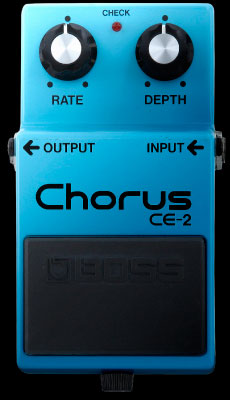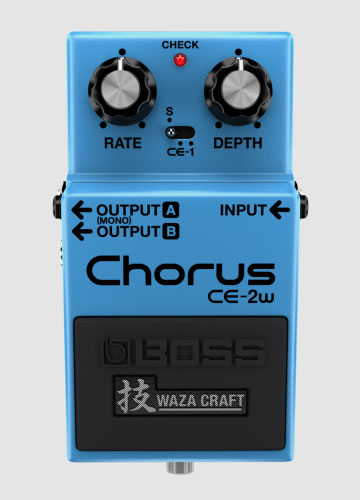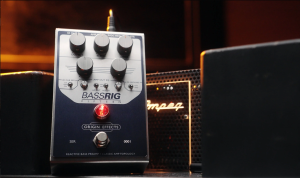Revisiting a Classic with Depth and Authority
The Origin: CE-2 and the Birth of Chorus Pedals
To understand the CE-2W, we need to go back to 1979, when Boss released the CE-2 Chorus — itself a refined, pedalboard version of the CE-1, the world’s first chorus pedal and an effect originally built into the legendary Roland JC-120 amp. The CE-2 was more compact, stripped-down to two knobs (Rate and Depth), and voiced with warmth and lush analog texture that became the benchmark for chorus pedals for decades.
It wasn’t designed with bassists in mind — and yet, it quickly became a cult favorite across all instruments for its lush, analog modulation that enhanced tone without washing it out. Bass players who did use it discovered that, at subtle settings, it brought out depth, width, and low-end bloom, making lines feel more alive and dimensional.

Enter Waza Craft: Reimagining the Legend
Boss’s Waza Craft line represents their high-end reissue and re-engineering approach — not just recreating vintage pedals but enhancing them with modern features and improved fidelity while staying true to the original analog designs.
The CE-2W, released in 2016, takes the heart of the CE-2 and adds:
- The original CE-2 mode (analog BBD circuit)
- The even earlier CE-1 chorus/vibrato mode
- Modern updates like stereo output and improved headroom
For bass players, this is a huge deal: it means one pedal can serve as a classic chorus, a vibrato-style modulator, and a widening stereo tool, all in one rugged enclosure — and all fully analog.
Why Chorus Works So Well on Bass
Chorus is often associated with shimmering guitar sounds, 80s power ballads, and crystalline clean tones. But on bass, it has a different magic — and the CE-2W is one of the best examples of how to do it right.
Here’s why it works:
- Low-end bloom: At subtle depth settings, chorus adds motion to sustained bass notes, creating a sense of size and softness without thinning the tone.
- Dimension and width: Especially with stereo output, it creates an immersive field — great for modern ambient or progressive setups.
- Synthy texture: With a pick or palm-muted lines, it adds movement and vibe reminiscent of analog synth chorus.
- Stacking utility: Use it after drive/fuzz to soften harsh edges or before reverb/delay to create washy, psychedelic textures.
Importantly, the CE-2W preserves low frequencies well, especially when used subtly. It’s not a clean blend pedal, but thanks to its analog BBD design, it doesn’t rob your tone of weight — something older chorus pedals often failed at.
Controls and Modes: Simple, Yet Deceptively Powerful
The CE-2W is elegantly simple, but it hides a surprising amount of flexibility:
- Rate: Controls modulation speed. Low for a gentle sway; high for wobbly vibrato.
- Depth: Determines intensity of the effect. Set low for thickness, high for dramatic swirling.
- Mode Switch:
- Standard (CE-2): Classic chorus — lush and subtle. Great for supportive tones.
- CE-1 Chorus: A deeper, wider modulation, more intense than CE-2 mode. Has a strong stereo character.
- CE-1 Vibrato: A pitch-wobbling effect, weird and wonderful — great for experimental or vintage-sounding setups.
The stereo output (available in CE-1 modes) is a huge bonus. Running to two amps, or amp + DI, or stereo in a DAW unlocks spaciousness that’s addictive, especially for ambient, post-rock, or synth-influenced bass work.

Tone on Bass: Rich, Supportive, Never Overbearing
On a passive bass with flatwounds, the CE-2W can evoke classic 80s fretless tones — think Pino Palladino or Mick Karn. On a modern active 5-string, it brings depth and motion to otherwise clinical sounds. It can be subtle enough for studio R&B or bold enough for synthwave or doom-inspired textures.
What’s especially impressive is how well it handles drive and fuzz before it. Many modulation pedals get messy or thin out with gain, but the CE-2W handles it gracefully. It works equally well:
- After drive/fuzz: To soften edges and spread tone.
- Before ambient pedals: To add natural movement into reverbs and delays.
- Standalone: For minimalists wanting a single effect to give their tone a new voice.
Pros and Cons
Pros:
- True analog BBD chorus with warm, vintage tone
- Three modes in one pedal — CE-2, CE-1 Chorus, and CE-1 Vibrato
- Stereo output adds modern flexibility
- Very bass-friendly — retains low-end and sits well in a mix
- Compact, durable Boss build quality
- Simple but musical controls
- Works equally well clean or with drive
Cons:
- No clean blend — extreme settings can modulate the fundamental too much
- No tone/EQ control — shaping requires external help
- Stereo only in CE-1 modes, not in CE-2
- Some might wish for more customization or presets
Conclusion: A Modern Analog Chorus for Serious Players
The Boss CE-2W Waza Craft is a beautiful evolution of a legendary pedal, retaining the analog charm of the original while offering modern utility for bass players who demand more from their modulation.
For those seeking a chorus that works without thinning your sound, that adds dimension, width, and movement without sacrificing clarity, and that bridges vintage and modern in a seamless package — the CE-2W is a standout.
Whether you’re after subtle depth for ballads, full-spectrum chorus for ambient textures, or even slightly warped vibrato tones for experimental playing, this pedal delivers. And unlike some boutique alternatives, it does so reliably, accessibly, and with timeless tone.
If you’ve written off chorus on bass, this pedal might just change your mind — or at least, make you want to sit down with it and listen to your tone evolve in real time.





